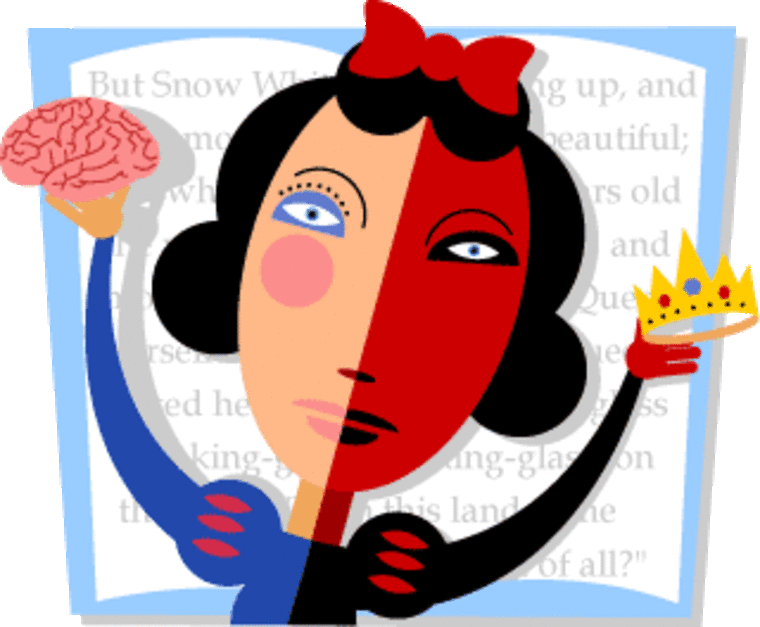With our belly- and breast-baring princesses of pop music, classic fairy tales probably seem tame to most parents. But authors of a recent report warn that many old tales should be read with a note of caution.
The trouble is beauty. “Fairy tales, which are still read by millions of American children, say it pays to be pretty,” says Purdue University sociologist Liz Grauerholz. She teamed up with Lori Baker-Sperry, an assistant professor of women’s studies at Western Illinois University, to determine how beauty is written about in classic Brothers Grimm fairy tales, which were originally brought to the United States in 1857.
“It’s important to understand the messages our children receive about traditional gender roles especially during a time when women are encouraged to be independent and rely on their brains rather than beauty,” Grauerholz says.
Of the 168 Grimm's fairy tales examined, the researchers concluded that the majority of the tales that survived until today feature characters with young, beautiful princesses such as Cinderella, Snow White and Sleeping Beauty. Their analysis showed that 94 percent of the Grimm's fairy tales acknowledge physical appearance, particularly female physical appearance.
The fact that fairy tales aren’t usually written about liberated girls and women isn’t a new concept, though. Since the 1970s social critics and feminists such as Alison Lurie, Andrea Dworkin and Susan Brownmiller have brought this to our attention. But the newest research tells us more: beauty sells -- even when the product is a fairy tale.
The tales that have become the most popular in terms of being remade into various books, movies or other media are the ones that acknowledge female beauty the most. “The new finding is the direct relationship between the number of mentions of female physical beauty and the number of times that a tale has been reproduced in the U.S.,” explains Baker-Sperry. For example, "Cinderella" has been made into various books and movies the most (332 times) and contains the highest number of mentions of female physical appearance (114), according to the study, published in the journal Gender and Society.
“The tale’s popularity says a lot about what our culture values,” says Baker-Sperry. “[These fairy tales] reinforce the message to children that physical attractiveness is an important asset women should aim to achieve and maintain.”
Most parents, of course, want their children to understand that girls –- and boys -- today can succeed by being smart, moral and hard-working; they don’t have to be beautiful or search for that prince or princess.
Inner beauty
But it would be a mistake to dismiss fairy tales out of hand, says Jack Zipes, a German professor at the University of Minnesota who is renowned for his scholarly work translating fairy tales. Correct interpretation -- not just counting words such as “beautiful” or “fair” -– is important, he says.
“The question of beauty in the Grimm's and other 19th century fairy tales is not limited to physical beauty,” Zipes says. “When the Grimm's [tales] note that a woman is beautiful, it also means that she is innerly beautiful -- virtuous, industrious, compassionate, true. These are some of the reasons why their female protagonists should not be dismissed.”
Zipes also notes that the Grimm's tales raise important basic questions about sibling rivalry, child abandonment and social class struggle that are still relevant today. For example, Hansel and Gretel, written in 1812, is the tale of a father and stepmother who abandon their two children.
Baker-Sperry doesn’t disagree that fairy tales are still relevant. In fact, she says she likes that they often also simplistically relay positive messages to children. And they can even offer hope to adults. When Disney released "Snow White" during the Great Depression and people couldn’t afford to eat, they bought tickets to see it, she notes. “[Fairy tale] symbolism really resonates with most of us," she says. "They typically have a very ‘American’ message: good will triumphs.”
Critical thinking
So parents don't need to throw away their fairy tales, Baker-Sperry says. “What I really want is for parents and childcare providers to talk to children as they’re reading," she says. "Don’t get rid of fairy tales, but do get your children to think.”
Baker-Sperry and Zipes offer these tips for healthier consumption of fairy tales:
- Don’t ban fairy tales. This is akin to banning candy. If children don't see or read them at home, they’ll do so at school or their friends’ homes.
- Start a dialogue. Ask questions after viewing the film or reading the book -– particularly questions directly related to the portrayal of female beauty or other messages you want them to ponder. For example: What do you think the prince likes about Cinderella other than how she looks? What do you think Cinderella likes about the prince? “You want them to think critically. That’s the key. Ask questions that make them think,” says Baker-Sperry.
- Have older children rewrite the tale. They could change the protagonist so he or she is kind and smart, but not necessarily beautiful or handsome. Alternately, ask them to write a story where Cinderella decides against marrying the prince. It’ll make them consider other possibilities.
- Reward authors and filmmakers who create more interesting and progressive tales. Some modern fairy tales and fairy-tale films still offer the simplistic message of good over bad but they’ve done away with the sexist stereotypes. Zipes recommends "Ever After," "Freeway," "Shrek" and the fairy-tale films in Jim Henson's series "The Storyteller."
- Have your antenna up for all media. Many books, movies, commercials and television shows are essentially retellings of fairy tale themes. Adults can encourage their children to question the messages in all these formats.
Victoria Clayton is a freelance writer based in California.
